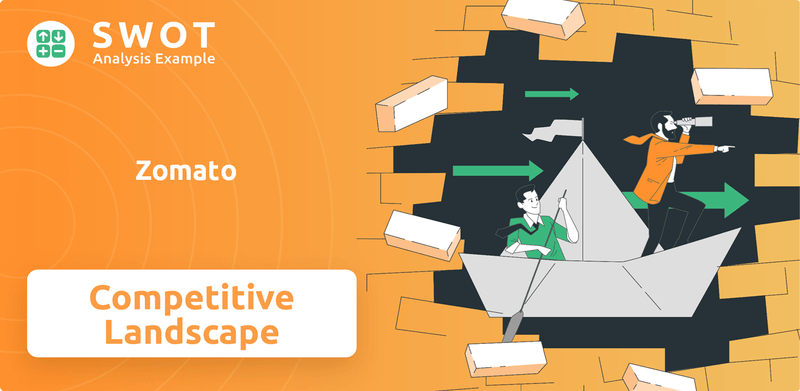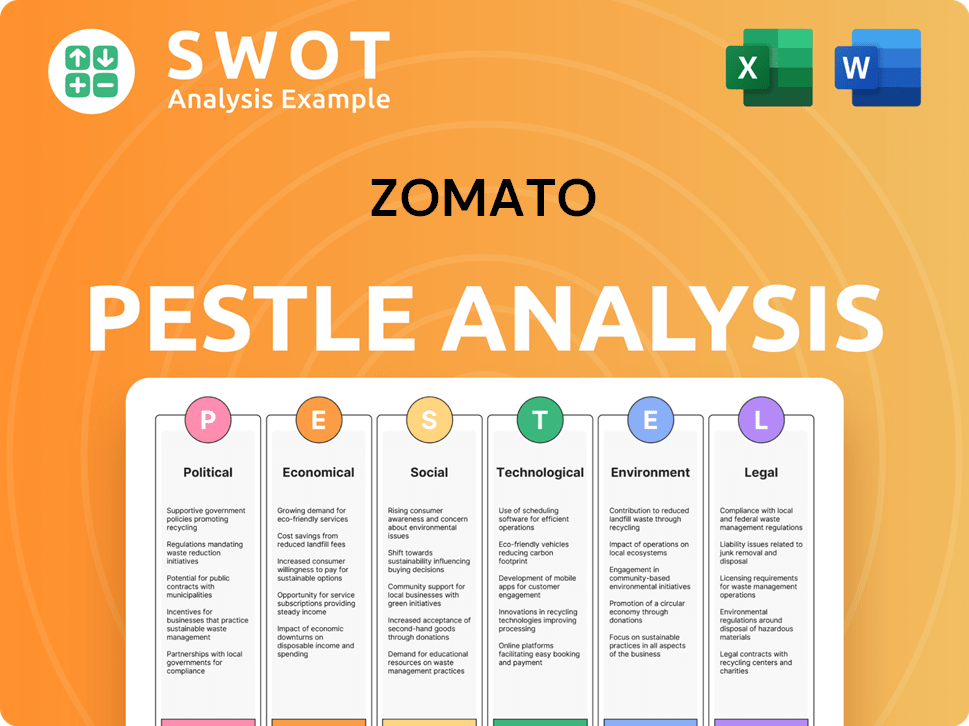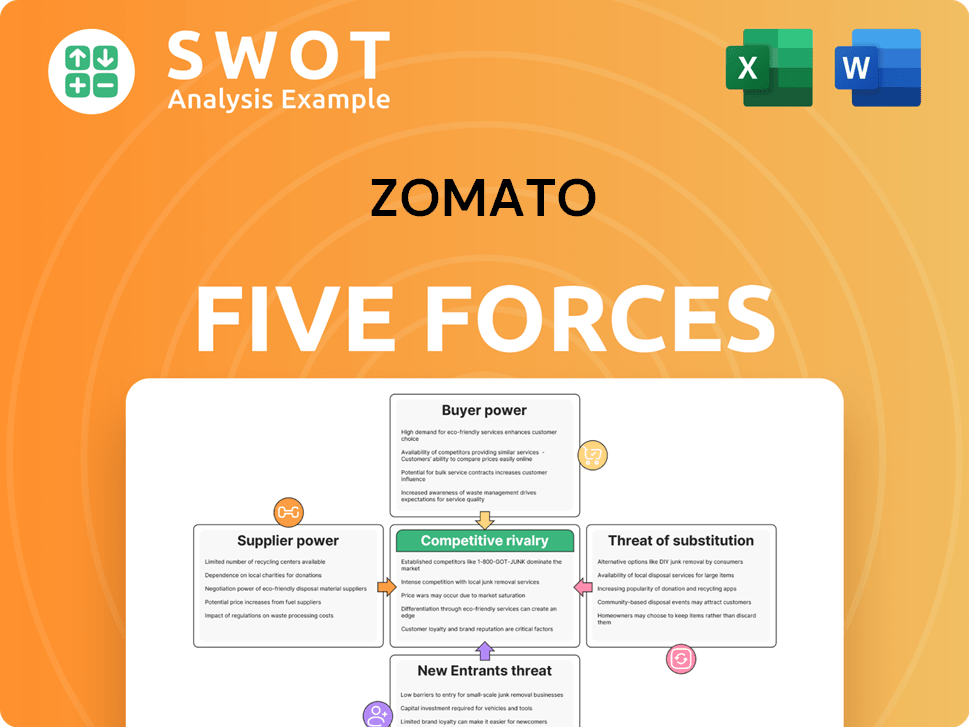Zomato Bundle
Can Zomato Maintain its Dominance in the Cutthroat Food Tech Arena?
The online food delivery industry is a battlefield, and Zomato has been a key player since 2008. Facing evolving consumer demands and rapid technological advancements, Zomato's journey from a restaurant discovery platform to a publicly listed giant is a testament to its strategic prowess. But what does the Zomato SWOT Analysis reveal about its position in this dynamic market?

This exploration of the Zomato competitive landscape will dissect its market positioning, identify its key Zomato competitors, and analyze its competitive advantages. We'll delve into Zomato's market share compared to competitors, examining how it differentiates itself in the online food ordering and restaurant aggregator space. Furthermore, we will explore Zomato's expansion plans and the impact of industry trends shaping its future, providing a comprehensive Zomato market analysis.
Where Does Zomato’ Stand in the Current Market?
Zomato holds a significant market position within the Indian online food delivery and restaurant discovery industry. It often competes for market leadership. Along with Swiggy, Zomato dominates the Indian food delivery market. The company's primary offerings include restaurant search and discovery, online food ordering and delivery, and its B2B Hyperpure segment, which supplies ingredients to restaurants.
The company's geographic focus is predominantly within India, with a strong presence in major metropolitan areas and expansion into smaller cities. Zomato has evolved from a restaurant discovery platform to a comprehensive food tech ecosystem. This includes premium services like Zomato Gold and its loyalty programs, as well as its push into quick commerce through Blinkit.
Financially, Zomato reported a consolidated adjusted EBITDA of ₹125 crore in Q3 FY24, demonstrating its path toward profitability. The food delivery segment showed strong performance, with adjusted revenue growing by 29% year-over-year in Q3 FY24. The company has scaled back its international operations to focus on its core market.
Zomato, alongside Swiggy, leads the Indian food delivery market. In Q3 FY24, Zomato's gross order value (GOV) grew by 13% year-over-year. This indicates continued expansion and strong consumer adoption within the Growth Strategy of Zomato.
Zomato reported a consolidated adjusted EBITDA of ₹125 crore in Q3 FY24. The food delivery segment saw adjusted revenue increase by 29% year-over-year in Q3 FY24, showcasing financial improvement. The company is focusing on profitability and scale.
Zomato has shifted from a restaurant discovery platform to a comprehensive food tech ecosystem. This includes premium services like Zomato Gold and its loyalty programs. The company has expanded into quick commerce through Blinkit.
Zomato's primary market is India, with a strong presence in major metropolitan areas. The company is expanding into smaller cities. International operations have been scaled back to focus on the core market.
Zomato's competitive landscape is primarily shaped by its rivalry with Swiggy. Key factors include market share, revenue growth, and strategic initiatives. The company's focus is on expanding its food delivery services and diversifying into quick commerce.
- Dominance in the Indian food delivery market.
- Strong revenue growth in the food delivery segment.
- Strategic expansion into quick commerce through Blinkit.
- Focus on profitability and scaling operations.
Zomato SWOT Analysis
- Complete SWOT Breakdown
- Fully Customizable
- Editable in Excel & Word
- Professional Formatting
- Investor-Ready Format

Who Are the Main Competitors Challenging Zomato?
The Zomato competitive landscape is heavily influenced by a mix of direct and indirect rivals, all vying for market share in the rapidly evolving food delivery industry. Understanding these competitors and their strategies is crucial for assessing Zomato's market analysis and future growth prospects. The competition is fierce, marked by constant innovation and strategic maneuvering.
The primary challenge comes from direct competitors like Swiggy, which offers similar services and often engages in aggressive marketing and pricing strategies. Beyond direct rivals, Zomato also faces indirect competition from cloud kitchens, D2C food brands, and quick commerce platforms. This diversified competitive environment requires Zomato to continuously adapt and innovate to maintain its position.
To gain a deeper understanding of Zomato's strategic positioning, consider exploring the Target Market of Zomato, which provides insights into its customer base and how it differentiates itself from competitors.
Swiggy is Zomato's most significant direct competitor in India. Both companies offer online food ordering and delivery services. The competition is intense, involving pricing wars, exclusive restaurant partnerships, and customer loyalty programs.
Cloud kitchens and direct-to-consumer (D2C) food brands represent an indirect challenge. These entities bypass traditional restaurant partnerships and use their own delivery mechanisms. They compete by offering unique menus and direct customer engagement.
Quick commerce platforms, such as Zepto and BigBasket (owned by Tata Digital), also pose a competitive threat. These platforms compete for consumer spending on immediate needs, particularly as Zomato expands its presence in this space through Blinkit.
The potential entry of new players or strategic alliances, such as collaborations between e-commerce giants and food delivery services, could further reshape the competitive dynamics. These alliances could bring new resources and strategies to the market.
Other restaurant aggregators, although smaller in scale, also compete for market share. These platforms focus on specific niches or geographic areas, offering specialized services.
In certain international markets, Zomato faces competition from global food delivery services. These companies bring established brands and resources to the competitive landscape.
The Zomato competitive landscape is dynamic, with market share fluctuating based on various factors. Pricing strategies, service quality, and marketing campaigns significantly influence consumer choices. Both Zomato and Swiggy have been involved in aggressive marketing campaigns and discount wars to capture a larger market share.
- Market Share Fluctuations: Market share is constantly shifting based on pricing, service quality, and marketing efforts.
- Pricing Strategies: Both Zomato and Swiggy use discounts and promotional offers to attract customers.
- Service Quality: Delivery times, order accuracy, and customer service are crucial for maintaining customer loyalty.
- Exclusive Partnerships: Securing exclusive partnerships with popular restaurants gives a competitive edge.
- Technological Innovation: Investments in technology, such as AI-driven recommendations and efficient delivery logistics, are essential.
Zomato PESTLE Analysis
- Covers All 6 PESTLE Categories
- No Research Needed – Save Hours of Work
- Built by Experts, Trusted by Consultants
- Instant Download, Ready to Use
- 100% Editable, Fully Customizable

What Gives Zomato a Competitive Edge Over Its Rivals?
Zomato's competitive advantages are built on strong brand equity, an extensive restaurant network, and a growing technological infrastructure. Its early entry into the Indian market, initially as a restaurant discovery platform, allowed it to build significant brand recognition and customer loyalty. This brand strength translates into a lower customer acquisition cost compared to newer entrants. Furthermore, Zomato boasts a vast network of partner restaurants, providing consumers with a wide variety of culinary choices, a crucial factor in attracting and retaining users.
The company strategically uses data analytics to personalize user experiences, optimize delivery routes, and offer valuable insights to its restaurant partners. Zomato's investment in its B2B Hyperpure segment, which supplies fresh and quality ingredients to restaurants, diversifies its revenue streams and strengthens its relationships with restaurant partners, creating a more integrated ecosystem. The acquisition of Blinkit further expands Zomato's competitive edge by venturing into the quick commerce segment, allowing it to leverage its existing delivery infrastructure and customer base for a broader range of products beyond food. These advantages have evolved from simply being a directory to becoming a comprehensive food and grocery tech platform, allowing Zomato to capture a larger share of the consumer's wallet.
While these advantages are substantial, they face threats from aggressive pricing by competitors and the constant need for technological innovation to stay ahead in a rapidly evolving digital landscape. Understanding the Revenue Streams & Business Model of Zomato is crucial to assessing its competitive position.
Zomato's early mover advantage in the Indian market established strong brand recognition. This has resulted in lower customer acquisition costs compared to its rivals. The company has cultivated significant customer loyalty over the years, which is a key factor in retaining its user base within the competitive food delivery industry.
Zomato's extensive network of partner restaurants provides a wide array of culinary choices for consumers. This extensive selection is a critical factor in attracting and retaining users. The broad availability of options helps Zomato maintain its position as a leading restaurant aggregator.
Zomato leverages data analytics to personalize user experiences and optimize delivery routes. These data-driven insights also provide valuable information to its restaurant partners. The company's focus on data enhances its competitive edge in the online food ordering market.
Zomato's investment in Hyperpure and the acquisition of Blinkit have expanded its competitive scope. Hyperpure strengthens relationships with restaurant partners, while Blinkit allows Zomato to enter the quick commerce segment. These strategic moves enhance Zomato's overall market presence and its ability to capture a larger share of the consumer's wallet.
Zomato's competitive advantages include strong brand recognition, an extensive restaurant network, and strategic use of data analytics. These factors contribute to its ability to attract and retain customers in a competitive market. The company's investments in Hyperpure and Blinkit further enhance its market position.
- Brand Equity: Zomato's established brand is a significant asset, reducing customer acquisition costs.
- Restaurant Network: A wide selection of restaurants attracts and retains users.
- Data Analytics: Personalization and optimized delivery routes improve user experience.
- Strategic Investments: Hyperpure and Blinkit expand service offerings and strengthen partner relationships.
Zomato Business Model Canvas
- Complete 9-Block Business Model Canvas
- Effortlessly Communicate Your Business Strategy
- Investor-Ready BMC Format
- 100% Editable and Customizable
- Clear and Structured Layout

What Industry Trends Are Reshaping Zomato’s Competitive Landscape?
The online food delivery and quick commerce sectors are evolving rapidly, presenting both challenges and opportunities for companies like Zomato. Technological advancements, regulatory changes, and shifting consumer preferences are key factors shaping the industry. Understanding the Zomato competitive landscape requires a close look at these trends and their impact on the company's strategic direction.
For Zomato, navigating this dynamic environment involves managing profitability, expanding market reach, and adapting to evolving consumer demands. The company's success hinges on its ability to leverage technology, innovate its services, and maintain a strong competitive position against rivals. The food delivery industry is highly competitive, and Zomato's ability to differentiate itself will be crucial for sustained growth.
Technological advancements, such as AI-driven logistics, are improving efficiency. Consumer preferences are shifting towards healthier options and instant gratification. Regulatory changes, particularly around gig economy workers, impact operational costs. The restaurant aggregator faces constant pressure to innovate and adapt.
Maintaining profitability amidst intense competition and high logistics costs remains a key challenge. The quick commerce segment is capital-intensive and highly competitive. Economic reopening and the return to dine-in experiences could impact online food delivery demand. The emergence of new competitors poses a constant threat.
Expansion into underserved Tier 2 and Tier 3 cities in India presents a significant untapped market. Leveraging data insights to personalize offerings and enhance customer loyalty can drive growth. Innovations in delivery models, such as drone delivery, could revolutionize efficiency. Strategic partnerships can unlock new revenue streams.
Zomato's foray into quick commerce with Blinkit allows it to capitalize on the growing demand for instant delivery. The company must adapt to industry trends, innovate services, and strategically expand offerings. Maintaining profitability and operational efficiency is crucial for long-term success. To understand how Zomato started, you can read the Brief History of Zomato.
Zomato’s market analysis reveals a need to balance growth with profitability. Expanding into new markets and diversifying services are key. The company must continuously innovate to stay ahead of its Zomato competitors.
- Focus on profitability in core food delivery operations.
- Strategic investments in quick commerce, like Blinkit.
- Leveraging data for personalized customer experiences.
- Exploring innovative delivery solutions.
Zomato Porter's Five Forces Analysis
- Covers All 5 Competitive Forces in Detail
- Structured for Consultants, Students, and Founders
- 100% Editable in Microsoft Word & Excel
- Instant Digital Download – Use Immediately
- Compatible with Mac & PC – Fully Unlocked

Related Blogs
- What are Mission Vision & Core Values of Zomato Company?
- What is Growth Strategy and Future Prospects of Zomato Company?
- How Does Zomato Company Work?
- What is Sales and Marketing Strategy of Zomato Company?
- What is Brief History of Zomato Company?
- Who Owns Zomato Company?
- What is Customer Demographics and Target Market of Zomato Company?
Disclaimer
All information, articles, and product details provided on this website are for general informational and educational purposes only. We do not claim any ownership over, nor do we intend to infringe upon, any trademarks, copyrights, logos, brand names, or other intellectual property mentioned or depicted on this site. Such intellectual property remains the property of its respective owners, and any references here are made solely for identification or informational purposes, without implying any affiliation, endorsement, or partnership.
We make no representations or warranties, express or implied, regarding the accuracy, completeness, or suitability of any content or products presented. Nothing on this website should be construed as legal, tax, investment, financial, medical, or other professional advice. In addition, no part of this site—including articles or product references—constitutes a solicitation, recommendation, endorsement, advertisement, or offer to buy or sell any securities, franchises, or other financial instruments, particularly in jurisdictions where such activity would be unlawful.
All content is of a general nature and may not address the specific circumstances of any individual or entity. It is not a substitute for professional advice or services. Any actions you take based on the information provided here are strictly at your own risk. You accept full responsibility for any decisions or outcomes arising from your use of this website and agree to release us from any liability in connection with your use of, or reliance upon, the content or products found herein.